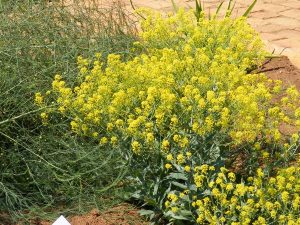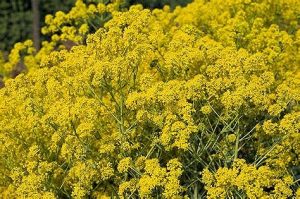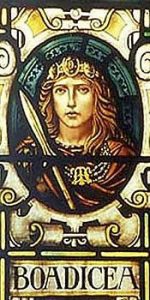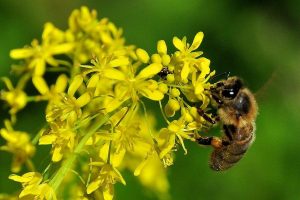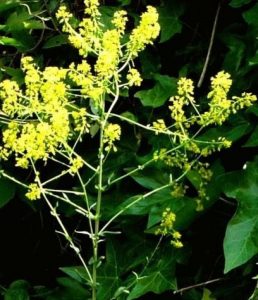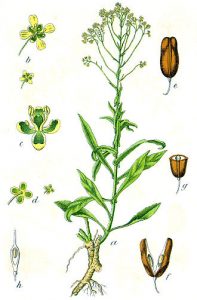WOAD (Isatis tinctoria)
Afghanistan, Western Tibet, Southern Russia
Woad is a famous member of the brassica family whose bright YELLOW flowers appear from June to August in the UK. This is a plant that prefers sun or part shade, but will adapt to soils that are well-drained, neutral or alkaline. It will tolerate poor, infertile soil.
It is biennial – in its first year it develops a rosette of downy blue-green leaves & puts down a deep taproot. In its second year it sends up stems that are 3-4 ft tall (90-120 cm), flowering earlier than other plants that attract beneficial pollinators.
An Ancient Dye Plant
From the Stone Age, Isatis tinctoria was the source of blue colouring in Europe. It was said to have provided the dye with which the Celts (Boudicca and the Iceni in East Anglia, the Picts further north) painted their bodies before battle.
Julius Caesar wrote ‘All the Britons dye their bodies with woad, which produces a blue colour and gives a wild appearance in battle.’ Woad could have been slathered/tattooed onto warriors’ wounds for its healing properties, with the wild appearance of a blue-painted adversary in battle an unintended consequence.
‘Did the Celts wear War Paint?’ World History FAQ, Christian Christensen
This blue dye was used for textiles and medieval illustration. It became part of a thriving trade; England, France, Italy and Germany all had Woad-growing areas.
The plant’s leaves were chopped & mashed into a paste; this was rolled into balls that were dried & could then be traded.
The Woad balls were pulverised, sprinkled with water & left to ferment. The crumbly substance thus produced was then dried & packed into barrels, to be sent off for sale. http://www.jennydean.co.uk/index.php/using-woad-balls/ https://en.wikipedia.org/wiki/Isatis_tinctoria
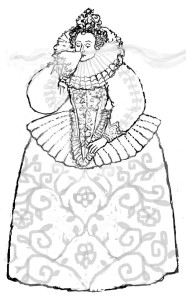 Woad was much used in dye-making in the Middle Ages. But so foul was the smell produced by the fermentation process that Queen Elizabeth I banned dye being made from Woad within 5 miles (8 km) of any of her palaces. RHS ENCYCLOPEDIA of HERBS, Demi Bown
Woad was much used in dye-making in the Middle Ages. But so foul was the smell produced by the fermentation process that Queen Elizabeth I banned dye being made from Woad within 5 miles (8 km) of any of her palaces. RHS ENCYCLOPEDIA of HERBS, Demi Bown
The size of the medieval wool trade & Woad’s place in it can be seen in this example from our Bees Favourites/Teasel page : ‘An early consignment example was that of 1331-32 when 18,000 teasels landed at Exeter in a ship with woad and weld (used for dyes) from the Low Countries’… https://www.exploringbuildinghistory.co.uk/the-teasel-in-the-english-woollen-cloth-industry/
A Future for Woad
The Woad to a Sustainable Blue : How we colour our clothes… Natural dyes (woad & indigo from India) are compared with the synthetic indigo dyes of today, made with toxic chemicals. Encourages us to take up growing woad for dyeing. Looks into the history of woad & how to plant, grow and harvest it, knitting, thrift shops, landfill.
sustainable clothing dye gardening dye techniques tutorials creative spark earth care splatters
https://www.wearingwoad.com/the-woad-to-a-sustainable-blue-finding-sustainability-in-an-unsustainable-world/
The Woad Centre in Norfolk, UK is the only commercial woad production centre in Britain. From their arable farm on onetime Iceni territory in the days of Boudicca, Ian Howard and wife Bernadette have diversified into pigment production from plants, specialising in woad and weld. They work with local artisans on unique woad-based products & traditional crafts – homewares, clothing & accessories. Showroom & exhibition space at Woad Barn The History of Woad and Links workshops Tripadvisor
Ian continues to give talks, lectures and demonstrations as well as consultancy work. Details available on request. www.thewoadcentre.com
The Woad Centre, Woad Barn, Rawhall Lane. Beetley, Dereham. Norfolk NR20 4HH (UK)
Medicinal
Antimicrobial, antifungal. Made into an ointment for ulcers, oedematous and malignant tumours; https://www.healthdictionary.org/isatis-tinctoria Indian Medicinal Plants / Health Dictionary
Ancient medicinal herb. Known as a cooling herb, Banlangen, in traditional Chinese medicine. The root is used to treat colds & flu & to alleviate fevers & sore throats, respiratory illnesses & liver diseases.
Woad – Use for Treatment of Viral Diseases – Sideritis.info https://en.sideritis.info/woad-use-for-treatment-of-viral-diseases/
Bees’ Favourite
Isatis tinctoria is known for attracting bees, beneficial insects and other pollinators. It has nectar/pollen rich flowers.
BBC Gardeners World Magazine
Other names: Asp of Jerusalem, Base-broom, Da Qing Ye (Chinese), Der Waid (German), Dyer’s Broom, Dyer’s woad, Farberginster, Genet des Teinturiers, Glaisin (old Irish), Glasrac (Scots-Gaelic), Glastum, Glesyn (Welsh), Goud, Greenweed, Greenwood, Guado (Italian), Gualda (Spanish), Guede (French), Isatis (Greek), Isatis Indigotiga, Morsinko (Finnish), Ode, Pastel (Spanish & French), Urzet (Polish), Vaida (Russia), Vajd (Danish), Vejde (Swedish), Vejt (Czech), Vitro (Latin), Wad (Anglo-Saxon, old English), Weat, Wede (Dutch), Woad Leaf, Wood-waxen (formerly Wede-wixen or Woud-wix.)
For one season we tried Woad in the garden, bringing back a young plant from the Centre for Wildlife Gardening, Peckham. It was early in the year and they recommended it as something in bloom for bees before most other flowers.
Slugs & snails loved it, so it was kept in a pot & moved from place to place until it flowered. Its bright YELLOW flowers brought in no pollinators that we could see. Reading about it on the internet now, it is obviously a plant worth revisiting. Perhaps in our part of North London the early bees were not up and about yet… perhaps it was one of those damp & rainy springs when slugs & snails ruled.
Invasive
Considered a noxious weed when introduced outside its European range.
‘Isatis tinctoria is a herbaceous dye plant which has spread, often by human intervention, widely from its area of origin in central Asia or southeast Russia. Long valued for the dye it produces, it is of pest status in alkaline soils of some western states of the United States. Its fruits have germination-inhibiting factors and the plant produces glucosinates which may alter soil microbiological properties. It causes considerable production losses of desired plants in rangelands.
You should be aware that some states have put restrictions on growing woad due to its invasive nature. These states include Oregon, New Mexico, Washington, Colorado, Nevada, Arizona, Utah, California, Idaho, Montana, and Wyoming. So before you grow it in your garden, you should check the local regulations.’ Woad Plant – Isatis Tinctoria – How to Grow and Use Woad Plant Dyes – Mozilla Firefox
